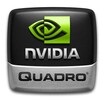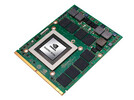NVIDIA Quadro M620 vs NVIDIA Quadro M4000M vs NVIDIA Quadro 5010M
NVIDIA Quadro M620
► remove from comparisonThe 28nm NVIDIA Quadro M620 is a mid-range DirectX 12 (FL 11_0) and OpenGL 4.5-compatible graphics card for mobile workstations. It is a 1st generation Maxwell-based GPU built on the GM107 architecture with 512 of the 640 shader cores activated. Therefore, the GPU is not similar to any current consumer card. The Geforce GTX 950M, for example, uses the full 640 shader cores. The older Quadro M1000M offers very similar specs (same amount of shader cores and also based on the same chip but more graphics memory), but was intended for the Skylake generation. The M620 is intended for the Kaby Lake generation.
The Quadro series offers certified drivers that are optimized for stability and performance in professional applications like CAD or DCC. OpenGL performance, for example, should be significantly better compared to GeForce graphics cards of similar specifications.
Performance
Due to the smaller amount of memory, the Quadro M620 should be slightly slower than the older Quadro M1000M. However, the exact clock speeds are not known up to now. In early benchmarks we have, the M1000M is about 9 % faster than the M620 in SPECviewperf 12.
Using CUDA (Compute Capability 5.0) or OpenCL 1.2, the cores of the Quadro M620 can be used for general calculations.
Power Consumption
The power consumption of the Quadro M620 is rated for a 30 Watt TGP including the board and memory components (21.2 Watt TDP), which is 10 Watt lower than the M1000M (which offers more memory). Therefore, the card is suited for 15-inch notebooks and greater.
NVIDIA Quadro M4000M
► remove from comparison
The Nvidia Quadro M4000M is a high-end, DirectX 12 (FL_12_1) and OpenGL 4.5-compatible graphics card for mobile workstations. It is a Maxwell-based GPU built on the GM204 chip with all 1280 of the 1536 shader cores activated and is manufactured in 28 nm at TSMC. Therefore, the GPU is similar to the consumer Nvidia GeForce GTX 970M. The Quadro M4000M is built for the Intel Skylake generation and is a successor to the Quadro K4100M (Kepler-based). The M4000M usually comes with 4 GB GDDR5 VRAM clocked at 1250 MHz (5000 MHz effective, 160 GB/s opposed to 102.4 GB/s of the K4100M).
The Quadro series offers certified drivers that are optimized for stability and performance in professional applications like CAD or DCC. OpenGL performance, for example, should be significantly better compared to GeForce graphics cards of similar specifications.
Performance
The clock speeds of the Quadro M4000M are very similar to the GTX 970M based on the same chip. The base clock is slightly higher with 975 versus 924 MHz but the Boost speed is lower at 1013 versus 1038 MHz. Therefore, with good cooling the GTX 970M should be slightly faster. Compared to the Quadro line-up, it is the second fastest Quadro card in 2015 and therefore clearly faster than the old Quadro K4100M.
Using CUDA (Compute Capability 5.2) or OpenCL 1.2, the cores of the Quadro M4000M can be used for general calculations.
Power Consumption
The power consumption of the Quadro M4000M is rated at the same TGP of 100 Watt as the M5000M and older K5100M/K4100M (including the board and memory components). Therefore, the card is suited for large notebooks with 17-inch displays or greater.
NVIDIA Quadro 5010M
► remove from comparison
The NVIDIA Quadro 5010M is a professional workstation graphics card based on the Fermi architecture (GF100 chip). Therefore, the 5010M is closely related to the consumer GeForce GTX 480M. The Quadro 5010M is the successor to the Quadro 5000M and also offers ECC RAM and double-precision floating point cores.
The Quadro series offers certified drivers that are optimized for stability and performance in professional applications like CAD, DCC, medicine, or visualisation areas. The OpenGL performance, for example, should be significantly better than GeForce graphics cards with similar specifications.
The shader / CUDA cores can be accessed using DirectX 11 or OpenGL 4.1 for graphics rendering and DirectCompute, OpenCL, AXE, and CUDA for general purpose calculations. Due to the new Fermi architecture, the 5010M should offer higher levels of performance in general purpose calculations compared to its predecessors.
Furthermore, the Nvidia Quadro 5010M is compatible with the new stereoscopic solution by Nvidia called 3D Vision Pro.
To automatically switch between the integrated graphics card and the Quadro, the 5010M supports Nvidia Optimus. Note, however, that whether this feature is integrated or not depends on the notebook manufacturer.
Similar to the GeForce GTX 480M, the Quadro 5010M is specified at 100 Watt TDP. As a result, only very large laptops, such as the Clevo D901F, are able to house this high-end card.
At the time of arrival (Feb. 2011), the Quadro 5010M succeeds the older Quadrio FX 5000M as the fastest professional workstation graphic card for laptops.
| NVIDIA Quadro M620 | NVIDIA Quadro M4000M | NVIDIA Quadro 5010M | |||||||||||||||||||||||||||||||||||||||||||||||||||||||||||||||||||||||||||||||||||||||||||||||||||||||||||||||||||||||||||||||||||||||||||||||||||||||||||||||||||
| Quadro M Series |
|
|
| ||||||||||||||||||||||||||||||||||||||||||||||||||||||||||||||||||||||||||||||||||||||||||||||||||||||||||||||||||||||||||||||||||||||||||||||||||||||||||||||||||
| Architecture | Maxwell | Maxwell | Fermi | ||||||||||||||||||||||||||||||||||||||||||||||||||||||||||||||||||||||||||||||||||||||||||||||||||||||||||||||||||||||||||||||||||||||||||||||||||||||||||||||||||
| Pipelines | 512 - unified | 1280 - unified | 384 - unified | ||||||||||||||||||||||||||||||||||||||||||||||||||||||||||||||||||||||||||||||||||||||||||||||||||||||||||||||||||||||||||||||||||||||||||||||||||||||||||||||||||
| Core Speed | 1018 MHz | 975 - 1013 (Boost) MHz | 450 MHz | ||||||||||||||||||||||||||||||||||||||||||||||||||||||||||||||||||||||||||||||||||||||||||||||||||||||||||||||||||||||||||||||||||||||||||||||||||||||||||||||||||
| Memory Speed | 5012 MHz | 5012 MHz | 1300 MHz | ||||||||||||||||||||||||||||||||||||||||||||||||||||||||||||||||||||||||||||||||||||||||||||||||||||||||||||||||||||||||||||||||||||||||||||||||||||||||||||||||||
| Memory Bus Width | 128 Bit | 256 Bit | 256 Bit | ||||||||||||||||||||||||||||||||||||||||||||||||||||||||||||||||||||||||||||||||||||||||||||||||||||||||||||||||||||||||||||||||||||||||||||||||||||||||||||||||||
| Memory Type | GDDR5 | GDDR5 | GDDR5 ECC | ||||||||||||||||||||||||||||||||||||||||||||||||||||||||||||||||||||||||||||||||||||||||||||||||||||||||||||||||||||||||||||||||||||||||||||||||||||||||||||||||||
| Max. Amount of Memory | 2048 MB | 4 GB | 4 GB | ||||||||||||||||||||||||||||||||||||||||||||||||||||||||||||||||||||||||||||||||||||||||||||||||||||||||||||||||||||||||||||||||||||||||||||||||||||||||||||||||||
| Shared Memory | no | no | no | ||||||||||||||||||||||||||||||||||||||||||||||||||||||||||||||||||||||||||||||||||||||||||||||||||||||||||||||||||||||||||||||||||||||||||||||||||||||||||||||||||
| API | DirectX 12 (FL 11_0), Shader 5.0, OpenGL 4.5 | DirectX 12_1, Shader 5.0, OpenGL 4.5 | DirectX 11, Shader 5.0 | ||||||||||||||||||||||||||||||||||||||||||||||||||||||||||||||||||||||||||||||||||||||||||||||||||||||||||||||||||||||||||||||||||||||||||||||||||||||||||||||||||
| Power Consumption | 30 Watt | 100 Watt | 100 Watt | ||||||||||||||||||||||||||||||||||||||||||||||||||||||||||||||||||||||||||||||||||||||||||||||||||||||||||||||||||||||||||||||||||||||||||||||||||||||||||||||||||
| technology | 28 nm | 28 nm | 40 nm | ||||||||||||||||||||||||||||||||||||||||||||||||||||||||||||||||||||||||||||||||||||||||||||||||||||||||||||||||||||||||||||||||||||||||||||||||||||||||||||||||||
| Features | Optimus, PhysX, 3D Vision Pro, nView, Optimus | Optimus, PhysX, 3D Vision Pro, nView, Optimus | OpenGl 4.1, ECC Memory, FP64 IEEE 754 | ||||||||||||||||||||||||||||||||||||||||||||||||||||||||||||||||||||||||||||||||||||||||||||||||||||||||||||||||||||||||||||||||||||||||||||||||||||||||||||||||||
| Notebook Size | large | large | large | ||||||||||||||||||||||||||||||||||||||||||||||||||||||||||||||||||||||||||||||||||||||||||||||||||||||||||||||||||||||||||||||||||||||||||||||||||||||||||||||||||
| Date of Announcement | 13.01.2017 | 02.10.2015 | 22.02.2011 | ||||||||||||||||||||||||||||||||||||||||||||||||||||||||||||||||||||||||||||||||||||||||||||||||||||||||||||||||||||||||||||||||||||||||||||||||||||||||||||||||||
| Link to Manufacturer Page | www.nvidia.de | www.nvidia.com | www.nvidia.com | ||||||||||||||||||||||||||||||||||||||||||||||||||||||||||||||||||||||||||||||||||||||||||||||||||||||||||||||||||||||||||||||||||||||||||||||||||||||||||||||||||
| Transistors | 5.2 Billion | 3 Billion | |||||||||||||||||||||||||||||||||||||||||||||||||||||||||||||||||||||||||||||||||||||||||||||||||||||||||||||||||||||||||||||||||||||||||||||||||||||||||||||||||||
| Codename | N12E-Q5 | ||||||||||||||||||||||||||||||||||||||||||||||||||||||||||||||||||||||||||||||||||||||||||||||||||||||||||||||||||||||||||||||||||||||||||||||||||||||||||||||||||||
| Shader Speed | 900 MHz |
Benchmarks
3DM Vant. Perf. total + NVIDIA Quadro M620
specvp11 snx-01 + NVIDIA Quadro M620
specvp12 sw-03 + NVIDIA Quadro M620
Cinebench R15 OpenGL 64 Bit + NVIDIA Quadro M620
GFXBench T-Rex HD Offscreen C24Z16 + NVIDIA Quadro M620
Average Benchmarks NVIDIA Quadro M620 → 100% n=11
Average Benchmarks NVIDIA Quadro M4000M → 191% n=11
Average Benchmarks NVIDIA Quadro 5010M → 89% n=11
* Smaller numbers mean a higher performance
1 This benchmark is not used for the average calculation
Game Benchmarks
The following benchmarks stem from our benchmarks of review laptops. The performance depends on the used graphics memory, clock rate, processor, system settings, drivers, and operating systems. So the results don't have to be representative for all laptops with this GPU. For detailed information on the benchmark results, click on the fps number.

Rocket League
2017
Doom
2016
The Witcher 3
2015
Dirt Rally
2015
Total War: Rome II
2013
Company of Heroes 2
2013
BioShock Infinite
2013
StarCraft 2
2010
Metro 2033
2010
CoD Modern Warfare 2
2009Average Gaming NVIDIA Quadro M620 → 100%
Average Gaming 30-70 fps → 100%
Average Gaming NVIDIA Quadro M4000M → 274%
Average Gaming 30-70 fps → 311%
| NVIDIA Quadro M620 | NVIDIA Quadro M4000M | NVIDIA Quadro 5010M | |||||||||||||||||||
|---|---|---|---|---|---|---|---|---|---|---|---|---|---|---|---|---|---|---|---|---|---|
| low | med. | high | ultra | QHD | 4K | low | med. | high | ultra | QHD | 4K | low | med. | high | ultra | QHD | 4K | ||||
| Rocket League | 127.1 | 44.9 | 31.9 | 15.7 | |||||||||||||||||
| Warhammer 40.000: Dawn of War III | 70.3 | 18.7 | |||||||||||||||||||
| Doom | 60 | 36 | 22 | 17 | |||||||||||||||||
| Rise of the Tomb Raider | 59 | 34 | 19 | 14.4 | 4.9 | 90 | 55 | 48 | 20 | ||||||||||||
| Star Wars Battlefront | 110.6 | 64.3 | 28.92 | 24.37 | |||||||||||||||||
| The Witcher 3 | 53.9 | 32.83 | 18.62 | 10 | |||||||||||||||||
| Dirt Rally | 249 | 118.5 | 62 | 28.2 | |||||||||||||||||
| Total War: Rome II | 190.5 | 139.6 | 114.4 | 17.8 | |||||||||||||||||
| Company of Heroes 2 | 51.7 | 44.4 | 27.1 | 11.7 | |||||||||||||||||
| GRID 2 | 192.8 | 147.4 | 126 | 39.1 | |||||||||||||||||
| BioShock Infinite | 176.4 | 105.6 | 92.3 | 35.6 | 196 | 181 | 85 | ||||||||||||||
| NVIDIA Quadro M620 | NVIDIA Quadro M4000M | NVIDIA Quadro 5010M | |||||||||||||||||||
| low | med. | high | ultra | QHD | 4K | low | med. | high | ultra | QHD | 4K | low | med. | high | ultra | QHD | 4K | < 30 fps < 60 fps < 120 fps ≥ 120 fps | 3 3 5 | 1 5 3 2 | 5 1 3 1 | 7 2 | | 2 | < 30 fps < 60 fps < 120 fps ≥ 120 fps | | 1 1 | 1 1 | 1 1 | | 1 | < 30 fps < 60 fps < 120 fps ≥ 120 fps | | | | | | |
For more games that might be playable and a list of all games and graphics cards visit our Gaming List

























